
How much do you know about the men linked to Mary, Queen of Scots?
Test your knowledge of this Scottish queen’s love life with this fun crossword.
Simply click on the link or image below to open and print out…
[Read More...]
How much do you know about the men linked to Mary, Queen of Scots?
Test your knowledge of this Scottish queen’s love life with this fun crossword.
Simply click on the link or image below to open and print out…
[Read More...]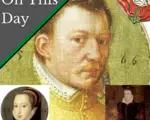
On this day in history, 29th April 1617, Sir Dru Drury died at the age of around 85 at his home, Riddlesworth Hall in Norfolk.
Drury may have died in the Stuart period, but he was a prominent Elizabethan. And he’s a man that went from being a prisoner to being Lieutenant of the Tower of London! Find out more about him…
[Read More...]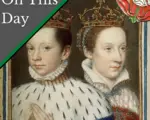
On this day in Tudor history, 24th April 1558, fifteen-year-old Mary, Queen of Scots, got married for the first time. The groom was fourteen-year-old Francis, the Dauphin of France.
Find out more about the bride and groom, their wedding and what happened to them…
[Read More...]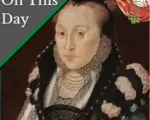
On this day in Tudor history, 20th April 1578, Lady Mary Keys (née Grey), sister of Lady Jane Grey and wife of Thomas Keys, died at her home in the parish of St Botolph without Aldgate, London.
Like her sisters, Mary had a sad life. Her secret marriage led to Elizabeth I imprisoning her and her husband, and they never saw each other again.
Find out more about the tiny Mary who was described as “crook-backed”, her marriage to a man who was said to be 6’8, and what happened to Mary and Thomas, in this video…
[Read More...]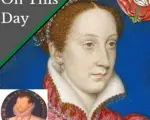
On this day in Tudor history, 19th April 1601, in Elizabeth I’s reign, bookseller James Duckett was hanged at Tyburn. Being a bookseller in Tudor times could be a risky business, particularly if you had the wrong kind of books on your premises!
[Read More...]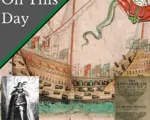
On this day in Tudor history, 16th April 1570, Gunpowder Plot conspirator Guy Fawkes was baptised in York.
In this video, I talk about how the Gunpowder Plot has its origins in the reign of Queen Elizabeth I and why these men were driven to try and blow up Westminster…
[Read More...]
On this day in Tudor history, 29th March 1555, in the reign of Queen Mary I, Protestant and former Dominican priest, John Laurence, was burned at the stake for heresy in Colchester.
At his burning, young children encouraged him with their prayers.
Find out more about his John Laurence’s sad end in this talk…
[Read More...]
On this day in Tudor history, 18th March 1554, Palm Sunday, the twenty-year-old Lady Elizabeth (the future Queen Elizabeth I) was escorted by barge from her home at Whitehall Palace along the River Thames to the Tower of London, and imprisoned there.
Elizabeth had been implicated in Wyatt’s Rebellion, a rebellion that sought to depose Queen Mary I and put Elizabeth, the queen’s half-sister, on the throne in her place.
Where was Elizabeth imprisoned? What happened to her? Find out more about Elizabeth’s arrest and her time in the Tower of London in this talk…
[Read More...]
On this day in Tudor history, 15th March 1532, King Henry VIII used what was described as “foul language” to William Warham, Archbishop of Canterbury.
Henry VIII also threatened the poor man, and it is amazing that Warham kept his head as the king was furious.
What happened? Find out what Warham did to upset the king in this talk…
[Read More...]
On this day in Tudor history, 9th March 1589, Lady Frances Radcliffe, Countess of Sussex, and wife of Sir Thomas Radcliffe, Lord Fitzwalter and 3rd Earl of Sussex, died at her home in Bermondsey.
Frances is known for being the benefactor of Cambridge University’s Sidney Sussex College, but there is much more to her than that. Her enemies even turned her husband and Queen Elizabeth I against her at one point!
Find out all about Frances Radcliffe (née Sidney) in this talk…
[Read More...]
On this day in history, 4th March 1609, Tudor spelling reformer and grammarian William Bullokar died at Chichester in West Sussex.
William Bullokar is known for writing the first grammar book of English, the “Pamphlet for Grammar”, and for his work reforming the alphabet to improve literacy.
Find out more about him and what he did in this talk…
[Read More...]
On this day in Tudor history, 3rd March 1542, Arthur Plantagenet, Lord Lisle, courtier, soldier, diplomat, administrator and illegitimate son of Edward IV, died of a heart attack after being informed of his release from the Tower of London. How very sad!
Find out all about Lord Lisle’s background, his career in Henry VII and Henry VIII’s reign, and how he came to imprisoned in the Tower of London, when he was probably innocent, in this talk…
[Read More...]
Well, ok, perhaps love at second or third sight!
On this day in Tudor history, Saturday 17th February 1565, Mary, Queen of Scots, met and fell in love with Henry Stuart, Lord Darnley, at Wemyss Castle in Scotland. Just over 7 months later, the couple got married.
Find out more about the background of this meeting between Mary, Queen of Scots and Lord Darnley, Mary’s thoughts on Darnley, and what happened next, in this talk…
[Read More...]
On this day in Tudor history, 8th February 1601, Robert Devereux, 2nd Earl of Essex and Queen Elizabeth I’s former favourite, did a rather foolish thing and raised a rebellion against the queen and her council.
Spoilers: It didn’t go well and he ended up being executed as a traitor.
Find out exactly what happened in this talk…
[Read More...]
As this week was the anniversary of the first marriage of Mary Boleyn, mistress of King Henry VIII and sister of Queen Anne Boleyn, on 4th February 1520, I thought I’d test your knowledge of this quite shadowy Tudor lady.
How much do you know about Mary Boleyn?
Get the little grey cells working with this fun crossword puzzle.
[Read More...]
On this day in Tudor history, Saturday 4th February 1520, Mary Boleyn, sister of Anne Boleyn, got married to William Carey in the Chapel Royal at Greenwich Palace, in a service attended by King Henry VIII.
Find out more about Mary Boleyn and William Carey in this talk…
[Read More...]
On this day in Tudor history, 3rd February 1537, in the reign of King Henry VIII, Thomas Fitzgerald, 10th Earl of Kildare (known as Silken Thomas), his five uncles and Sir John Burnell, were executed as traitors at Tyburn in London.
What led these men to these awful ends and why was Thomas known as “Silken Thomas”.
Find out more in this talk…
[Read More...]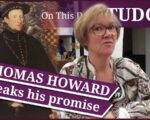
On this day in Tudor history, 16th January 1572, Thomas Howard, 4th Duke of Norfolk, eldest son of the late Henry Howard, Earl of Surrey, was tried and found guilty of treason at Westminster Hall.
Norfolk had promised Queen Elizabeth I that he would not get involved with Mary, Queen of Scots, ever again, but it was a promise that he just couldn’t keep. Once again, he had become involved in a plot against Elizabeth I and in support of Mary, Queen of Scots. He wouldn’t escape punishment this time.
Find out exactly what happened in this talk…
[Read More...]
On this day in Tudor history, 8th January 1571, Mary Shelton (married names: Heveningham and Appleyard) was buried at Heveningham Church, Suffolk.
Mary Shelton was Queen Anne Boleyn’s cousin and lady-in-waiting, and may also have been King Henry VIII’s mistress. She also contributed to the Devonshire Manuscript with the likes of Mary Howard, Lady Margaret Douglas and Lord Thomas Howard.
Find out more about Mary Shelton in this talk…
[Read More...]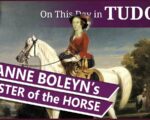
On this day in Tudor history, 8th December 1538, courtier and Master of the Horse to Queens Anne Boleyn and Jane Seymour, Sir William Coffin, died at Standon in Hertfordshire.
It is thought that he died of the plague because his wife Margaret wrote to Thomas Cromwell saying that Coffin had “died of the great sickness, full of God’s marks all over his body”.
Who was Sir William Coffin and what did the Master of the Horse do?
Find out in this talk…
[Read More...]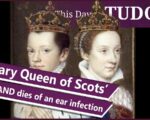
On this day in Tudor history, 5th December 1560, King Francis II of France, died at the age of just 15. Francis was King Consort of Scotland, as the husband of Mary, Queen of Scots, and his father had also proclaimed him and Mary as King and Queen of England back in 1558!
He was taken ill in mid-November with what appears to have been an ear infection, and it led to him dying on this day in history. His death led to Mary, Queen of Scots, returning to her homeland of Scotland, a country she hadn’t seen for 13 years.
Find out more about Francis II of France, his marriage to Mary, Queen of Scots, his death and what happened next, in this talk…
[Read More...]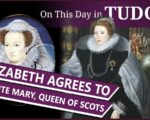
On this day in Tudor history, 2nd December 1586, following a joint petition from the Houses of Lords and Commons, Elizabeth I finally agreed to a public proclamation of sentence against Mary, Queen of Scots: death.
Mary had been found guilty of high treason back in October 1586, but Elizabeth had not wanted to contemplate regicide. However, Parliament believed that if Mary, Queen of Scots, was not executed, that she’d continue to plot against Elizabeth and would utterly “ruinate and overthrow the happy State and Common Weal of this most Noble Realm”. She was too much of a danger and needed dealing with once and for all.
Find out what Parliament said and what happened next in this talk…
[Read More...]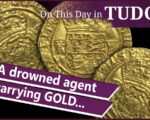
On this day in Tudor history, 28th November 1565, member of Parliament and political agent Francis Yaxley set sail for Scotland from Antwerp.
Sadly, Yaxley’s ship was wrecked in a storm and he never reached Scotland, and neither did the gold he was carrying to Mary, Queen of Scots.
But why was he carrying gold and who was it from? What happened to the gold?
Find out all about Yaxley, how he came to be traveling from Antwerp to Scotland, and what happened to him and the gold, in this talk…
[Read More...]
Today is the anniversary of the discovery of Gunpowder Plot conspirator, Guy Fawkes, and 36 barrels of gunpowder in a cellar beneath the Palace of Westminster on the night of 4th/5th November 1605. The plotters were planning to blow up the Houses of Parliament on the opening of Parliament and assassinate the king, his government and leading bishops and nobles.
But why and what has this event in James I’s reign got to do with Tudor history?
Well, a lot, because the Gunpowder Plot had its roots in Elizabeth I’s reign.
Find out more about the Gunpowder Plot, and those involved, in this talk…
[Read More...]
On this day in Tudor history, 27th October 1561, Mary Herbert (née Sidney), Countess of Pembroke, writer and literary patron, was born at Tickenhall, near Bewdley in Worcestershire. She was the sister of the poets Sir Philip Sidney and Robert Sidney, Earl of Leicester, was a writer herself and an extremely talented lady, and she also lived life to the full.
After her husband died, she had fun shooting pistols, flirting, taking tobacco and dancing. A fun lady!
Find out more about this gifted Tudor woman, who was as beautiful as she was talented, and whose work was praised, and used, by men such as Shakespeare.
[Read More...]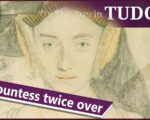
On this day in Tudor history, 20th October 1557, or possibly 21st, courtier Mary Arundell died at Bath Place in London.
Mary is an interesting Tudor lady. Not only did she serve at least two of Henry VIII’s wives, but she was a countess twice over, having been married to both the Earls of Sussex and Arundel. She has also been confused with two other Tudor ladies, and we don’t know whether the portrait you see in the thumbnail is really her.
Find out more about Mary Arundell’s life, court career and those of her husbands, in today’s talk from Claire Ridgway, founder of the Tudor Society.
[Read More...]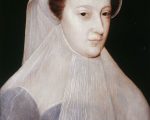
On this day in Tudor history, 14th October 1565, diplomat and poet, Sir Thomas Chaloner the Elder, died at his home in Clerkenwell, London. He was just forty-four years old. He’d served four Tudor monarchs as a diplomat, but he also wrote English and Latin works.
Find out more about Thomas Chaloner, his life, his career, and how his teeth saved him from death…
[Read More...]
On this day in Tudor history, 9th October 1547, Miguel de Cervantes, author of the famous classic “Don Quixote”, a book known as “the first modern novel”, was baptised in Alcalá de Henares, Spain. His actual birthdate is unknown.
Now, this event didn’t happen in Tudor England, but it did happen in the Tudor period, and Cervantes is known the world over. Let me share with you some facts about this man, his rather interesting life, which including being held to ransom by pirates, and his works…
[Read More...]
On this day in Tudor history, 5th October 1549, Edward Seymour, Duke of Somerset and Lord Protector, ordered a gathering of men at Hampton Court Palace, where he was lodged with the young King Edward VI, due to tensions mounting between Somerset and John Dudley, Earl of Warwick.
What was going on and what happened when 4,000 peasants turned up? How did John Dudley react and what did King Edward VI have to say about it all?
Find out what happened, and how this led to Somerset’s undoing…
[Read More...]
On this day in Tudor history, 2nd October 1514, eighteen-year-old Mary Tudor, sister of King Henry VIII, set off from Dover to sail to France to marry fifty-two-year-old King Louis XII of France.
Things hadn’t gone to plan with the scheduled sailing, due to bad weather, and Mary encountered rough seas on her journey too.
Find out about the arrangements for the journey, who was at Dover, Mary’s crossing to Boulogne, and what happened next…
[Read More...]